Tick numbers are on the rise! Over the past few years, the Canadian tick population has been growing, resulting in people having to remove ticks from themselves and their pets. Ticks are becoming more and more prevalent in North America, and they’re now being found in areas where people and pets didn’t previously encounter ticks. These parasites aren’t just a nuisance; they can cause serious—and sometimes deadly—diseases, including Lyme disease, Rocky Mountain spotted fever, babesiosis, ehrlichiosis, and tick paralysis.
Ticks are most often found in areas of overgrown grass, weeds, and low brush. Most tick species employ an “ambush” technique whereby they climb to the tip of the grass/brush waiting for a potential new “host” to walk by, as soon as contact is made, the tick releases the vegetation and jumps aboard! Some tick species mate before the ambush and then the female jumps onboard looking for a blood meal before laying her eggs. But most species jump aboard looking for a date. They will roam around their new host (person, pet or wild animal) for a day or two looking to mate with another tick. After mating, they search around for the best spot for a bite to eat and attach themselves for a blood meal. The male tick will eat sparingly, and will not engorge (or swell), but the female settles in for a big meal – after all, she has babies to feed! Some females will swell to 100x their pre-meal size before detaching and dropping off her host up to 10 days later. She will then digest her meal, grow her eggs and look around for a place to lay her eggs – 1000’s of them! Depending on the tick species a female may lay up to 6500 eggs at one time! It can take up to 2 years for those eggs to become adult ticks, but when they do there is an army of them.
Common Ticks in Ontario
The Black-Legged (Deer) Tick
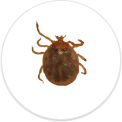
Nymph |
Male |
Female |
Female engorged after a blood meal |
This three-host tick tends to have a serial host preference:
Larvae feed on small rodents, birds, and reptiles. Nymphs feed on various small rodents, birds, cats, and humans. Adults feed on larger mammals including cats, dogs, and humans.

Habitat:
Most commonly found in the habitats of white-tailed deer, its primary reproductive host: deciduous forests (e.g., maple and oak) and surrounding grassy areas.
Diseases:
- Lyme Disease:
Lyme disease is caused by a spirochete (bacteria) that is commonly carried by rodents. Transmission of the bacteria happens when a tick bites an infected rodent and picks up the bacteria. The tick then passes the bacteria along when it bites a human or animal and feeds for as little as 24 hours. Not all ticks carry this bacteria that causes Lyme disease. Once infected, dogs may experience a stiff walk with an arched back, sensitivity to touch, a fever, lack of appetite, depression, inflammation of the joints and lymph nodes. Signs of Lyme disease usually occur weeks after a tick bite. However, most dogs do not develop clinical signs when infected with the bacteria. If a dog is diagnosed with Lyme Disease, this indicates there are infected ticks in the environment that could transmit the disease to humans, and strict tick control measures should be taken.
- Anaplasmosis:
Anaplasmosis is a tick-borne disease caused by an infectious bacteria. It is transmitted through bites of the deer tick (also known as the black-legged tick) and western black-legged tick. Anaplasmosis has been reported worldwide in a wide variety of animals.
Infection often causes lameness, joint pain, fever, lethargy, and not eating (inappetence). Most infected pets will have symptoms for 1 to 7 days; however, some will have no or only minor symptoms. Less common clinical signs include vomiting, diarrhea, coughing, and labored breathing. Rarely, neurological signs such as seizures have been reported.
It is considered a zoonotic pathogen. This means it has the potential to infect humans. However, direct transmission from animals to people or animal to animal is highly unlikely and has not been documented. Pets with anaplasmosis often have many of the same symptoms as those with Lyme disease, and infection with both diseases is not uncommon. Both Lyme disease and anaplasmosis are commonly found in the same geographic location and are transmitted by the same tick.
The Brown Dog Tick
|
Nymph |
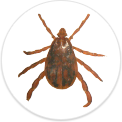 Male Male |
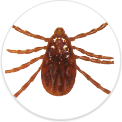 Female Female |
a blood meal |
This three-host tick tends to prefer dogs at all life stages:
Larvae, nymphs, and adults prefer to feed on dogs but also feed on other small mammals.
Habitat:
Most common in warm, subtropical climates in shaded sandy areas, as well as in cracks, crevices, and ceilings of houses and kennels.

Diseases:
- Ehrlichiosis
Like Lyme disease in dogs, symptoms of canine ehrlichiosis may not be obvious. If left untreated, these diseases could progress to a chronic (persistent) infection, which can last days, months or years without showing any symptoms. It is also a zoonotic disease, which means that people can contract the disease as well as pets. These diseases are particularly dangerous for young children, older adults and those with compromised immune systems.
Ehrlichia canis is an infection of white blood cells that can eventually affect bone marrow function, including the production of blood cells. Common symptoms can include any of the following:
- Depression and/or lack of energy
- Loss of appetite
- Runny eyes and nose/discharge
- Spontaneous nosebleeds
- Bruising on gums and belly
- Lameness/joint pain
Ehrlichiosis responds well to treatment with specific antibiotics. Improvement in symptoms is usually very quick, but several weeks of treatment is usually needed to ensure a full recovery. In severe cases where blood cell counts are very low, blood transfusions may be needed. Reinfection is possible, as immunity to Ehrlichia bacteria is not long lasting.
American Dog Tick
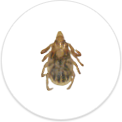
Nymph |
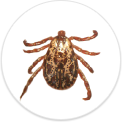 Male Male |
 Female Female |
a blood meal |
This three-host tick tends to have a serial host preference:
Larvae feed on numerous small mammals like mice and voles. Nymphs feed on larger animals like raccoons, cats, and dogs. Adults feed on larger animals, cats, dogs, and humans.

Habitat
Most commonly found in meadows and young forests, and along roadways and trails.
Diseases:
- Rocky Mountain Spotted Fever
Rocky Mountain Spotted Fever (RMSF), or Rickettsia rickettsii is one of the most commonly known tick-borne diseases to affect dogs and humans. It is also a potentially fatal disease that normally causes moderate to severe illness. In humans, it can appear as an abrupt onset of fever, malaise, headache, anorexia, nausea, vomiting, abdominal pain, photophobia, diarrhea and neck stiffness. The characteristic maculopapular rash usually appears 2-5 days after the other symptoms, starting on wrists and ankles before progressing to the rest of the body. 95% of children and 80% of adults have the rash; however, the absence of the rash is more common in fatal cases.
Certain breeds are more likely to develop a severe reaction to the R. rickettsii organism than others; these include purebred dogs and German shepherds. The signs and symptoms of RMSF vary according to the type of disease the dog has. Most dogs will develop a fever within five days of contracting Rickettsia rickettsii.Other symptoms include:
- Lethargy
- Anorexia
- Blood in the urine
- Irregular heartbeat (arrhythmia)
- Discolored spots on the skin, often bruised or purplish in color
- Inability to walk normally, loss of coordination (ataxia)
- Swelling or edema (fluid retention) in the limbs
- Bleeding that occurs suddenly, most often from the nose, or in the stools
- Difficulty with blood clotting, which can lead to shock or death
- Swollen lymph nodes
- Pain in the eyes
- Inflammation, hemorrhage, or conjunctivitis in the mucosal membranes, most commonly in the eyes
How do I Remove a Tick From Myself or My Pet?
Using tweezers or a tick removing tool, carefully grasp the ticks head and mouth as close to the skin as possible and gently pull the tick straight out. Do not twist as you pull and try not to squash the tick as you remove it. You can also call your local veterinary clinic and have them remove it for you. Save the tick in an empty pill bottle or a doubled zip-lock bag and call your veterinary hospital in order to potentially identify the species. No matter the species we strongly recommend an in-house blood test 6 weeks after the initial tick bite. The test takes only 15 minutes and can tell us if your pet has contracted Lyme disease as well as other tick-borne diseases.
What Can I Do to Help?
Keeping your pets safe from ticks is important. Ticks are actively looking for a meal as soon as the temperature reaches 4 degrees Celsius, no matter what season it is! Even if you avoid wooded areas and carefully check your pets after being outside, it’s still easy to miss ticks that may have crawled under the fur, or in the ears. Help keep your pets safe from ticks and tick-borne diseases by treating your pets with tick preventatives from your veterinarian. Don’t panic if you find a tick on your dog or cat, even if your pet is on a preventive as they kill ticks after they’ve come in contact with your pet.
Products
Some of the products we have to offer at the clinic to help prevent ticks include Advantix II, Simparica, and Bravecto. Please call or stop by the clinic to pick up your tick prevention and get some advice on which of our preventatives are best suited for you and your pet (as some products are more effective than others). We will instruct you on how to properly administer the medications, and for how long. We also now carry a vaccine to help prevent the contraction of Lyme disease in your dogs. Please note that we can only dispense your pet tick preventative medications (along with any other medications) if we have seen them for their Annual Wellness Visit with one of our veterinarians.



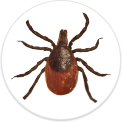
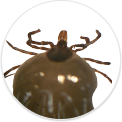


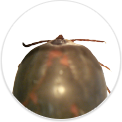 Female engorged after
Female engorged after
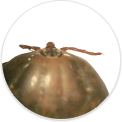 Female engorged after
Female engorged after